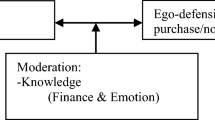Abstract
This study was undertaken to investigate the inclusion of a kosher claim in an advertisement for a familiar and unfamiliar brand of breakfast cereal. Results showed that, as hypothesized, for the familiar brand a kosher third party endorsement led to significantly more kosher attribute-related thoughts, more favorable product attitude and greater purchase intention. For the unfamiliar brand, no significant impact upon these dependent measures was observed given a kosher endorsement. Findings are interpreted from a cognitive perspective regarding the salience of the kosher attribute in a product familiarity context. Managerial implications are discussed.
Similar content being viewed by others
References
Adweek. 1987. “Kosher Designation Becoming Widespread.”Adweek’s Marketing Week (March 16): 16–17.
Assael, Henry. 1984.Marketing Management Strategy and Action. Boston: Kent Publishing Company.
Belch, George E. 1981. “An Examination of Comparative and Noncomparative Television Commercials: The Effect of Claim Variation and Repetition on Cognitive Response and Message Acceptance.”Journal of Marketing Research 18 (August): 333–349.
Berman, Phyllis. 1985. “Why Pastrami and Soap Don’t Mix.”Forbes (December 2): 134–136.
Bettman, James R. 1979.An Information Processing Theory of Consumer Choice. Reading, MA: Addison-Wesley.
Catlin, Jack. 1969. “Theoretical Notes on the Word-Frequency Effect.”Psychological Review 85 (May): 139–152.
Chamberlain, Ross. 1982. “Keep it Kosher: Dietary Law Enforcers Check Foods’ Production, Merchandising.”Quick Frozen Foods 44 (January): 20–22 & 64.
Crocker, Jennifer, Darlene B. Hannah, and Renee Weber. 1983. “Person Memory and Casual Attributions.”Journal of Personality and Social Psychology 44 (January): 55–66.
Cutler, Blayne. 1989. “Kosher Chic.”American Demographics 21 (June): 16.
Eidus, Janice (1989). “Kosher Products.”Adweek 39 (October 16): 47.
Engel, James F., Roger D. Blackwell, and Paul W. Miniard. 1986.Consumer Behavior. Fifth Edition. Chicago: The Dryden Press.
Fishbein, Martin, and Icek Ajzen. 1975.Beliefs, Attitude, Intention and Behavior: An Introduction to Theory and Research. Reading, MA: Addison-Wesley.
Forster, Kenneth I., and Susan M. Chambers. 1973. “Lexical Axis and Naming Time.”Journal of Verbal Learning and Verbal Behavior 12 (December): 627–635.
Friedman, Martin. 1989. “You Don’t Have to be Jewish to Love Kosher Foods.”Adweek 39 (June 19): 30.
Gardner, Meryl P. 1985. “Does Attitude Toward the Ad Affect Brand Attitude Under a Brand Evaluation Set?.”Journal of Marketing Research 22 (May): 192–198.
Gastwirt, Harold P. 1974.Fraud, Corruption and Holiness Port Washington, NY: Kennikat Press.
Greenwald, A.G., and J.S. Sakumura. 1967. “Attitude and Selective Learning: Where are the Phenomena of Yesteryear?.”Journal of Personality and Social Psychology 7 (July): 387–397.
Griess-Glabman, Maureen, 1982. “Keeping Fit in the World of Kosher Food.”Advertising Age (October 11): M42–M43.
Groves, Martha. 1989. “A Bid for Tradition.”The Los Angeles Times 109 (June 27): View Section 1&7.
Hamilton, David L., and Robert K. Gifford. 1976. “Illusory Correlation in Interpersonal Perception: A Cognitive Basis of Stereotypic Judgments.”Journal of Experimental Social Psychology 12 (November): 392–407.
Hastie, Reid, and Purohit Anand Kumar. 1979. “Person Memory: Personality Traits as Organizing Principles in Memory for Behaviors.”Journal of Personality and Social Psychology 37 (January): 25–38.
Johnson, Peter. 1989. “Kosher Foods Quality Lures Consumers of All Creeds,”USA Today (August 22, Section D): 5.
Klein, Issac. 1979.A Guide to Jewish Religious Practice. New York: The Jewish Theological Seminary of America.
Laric Michael V., and Dan Sarel. 1981. “Consumer (Mis) perceptions and Usage of Third Party Certification Marks, 1972 and 1980: Did Public Policy Have an Impact.”Journal of Marketing 45 (Summer): 135–142.
Lewis, Bea. 1987. “The Market Takes Off.”Newsday (January 21): 1&6 (Food Section).
Lipman, Joanne, 1989. “Ad Notes ... Kosher for Everyone.”The Wall Street Journal February 13: B6.
MacKenzie, Scott B., and Richard J. Lutz. 1989. “An Empirical Examination of the Structural Antecedents of Attitude Toward the Ad in an Advertising Pretesting Context.”Journal of Marketing 53 (April): 48–65.
Marks, Lawrence J., and Michael A. Kamins. 1988. “The Use of Product Sampling and Advertising: Effects of Sequence of Exposure and Degree of Advertising Claim Exaggeration on Consumers’ Belief Strength, Belief Confidence and Attitudes.”Journal of Marketing Research25 (August): 266–281.
Martineau, Pierre. 1957.Motivation in Advertising. New York: McGraw-Hill.
Meyers-Levy, Joan. 1989. “Investigating Dimension of Brand Names that Influence the Perceived Familiarity of Brands,” InAdvances in Consumer Research 16. Ed. Thomas K. Srull Provo, UT: Association for Consumer Research: 258–263.
Narayana, Chem L., and Rom J. Markin. 1975. “Consumer Behavior and Product Performance: An Alternative Conceptualization.”Journal of Marketing 39 (October): 1–6.
Olson, Jerry C., and Aydin Muderrisoglu. 1979. “The Stability of Responses Obtained by Free Elicitation: Implications for Measuring Attribute Salience in Memory Structure.” InAdvances in Consumer Research 6. Ed. William L. Wilkie. Ann Arbor, MI: Association for Consumer Research: 269–275.
Parkinson, Thomas L. 1975. “The Role of Seals and Certifications of Approval in Consumer Decision-Making.”Journal of Consumer Affairs 9 (Summer): 1–14.
Ries, Al, and Trout. 1986.Marketing Warfare. New York: McGraw-Hill.
Shimp, Terence A. 1981. “Attitude Toward the Ad as a Mediator of Consumer Brand Choice.”Journal of Advertising 10(2): 9–12.
Smith, Donald A., and Arthur C. Graesser. 1981. “Memory for Actions in Scripted Activities as a Function of Typicality Retention Interval, and Retrieval Taks.”Memory and Cognition 9 (November): 550–559.
Smith, Robert E., and William R. Swinyard. 1983. “Attitude-Behavior Consistency: The Impact of Product Trial Versus Advertising.”Journal of Marketing Research 20 (August): 257–267.
Srull, Thomas K. 1981. “Person Memory: Some Tests of Associative Storage and Retrieval Models.”Journal of Experimental Psychology 7 (June): 440–463.
Sujan, Mita. 1985. “Consumer Knowledge: Effects on Evaluation Strategies Mediating Consumer Judgments.”Journal of Consumer Research 12 (June): 31–46.
Trager, Cara S. 1987. “Kosher Symbol Becomes Strong Marketing Tool.”New York Daily News (March 6): 39.
Warmer, Joel, and Ronald E. McCray. 1969. “Influence of Word Frequency and Length on the Apparent Duration of Tachistoscopic Presentations,”Journal of Experimental Psychology 79 (January): 56–58.
White, Irving S. 1966. “The Perception of Value in Products.” inOn Knowing the Consumer. Ed. Joseph W. Newman. New York: John Wiley & Sons.
Wright, Peter L. 1973. “The Cognitive Processes Mediating the Acceptance of Advertising.”Journal of Marketing Research 10 (February): 53–62.
Author information
Authors and Affiliations
Rights and permissions
About this article
Cite this article
Kamins, M.A., Marks, L.J. The perception of kosher as a third party certification claim in advertising for familiar and unfamiliar brands. JAMS 19, 177–185 (1991). https://doi.org/10.1007/BF02726494
Issue Date:
DOI: https://doi.org/10.1007/BF02726494




